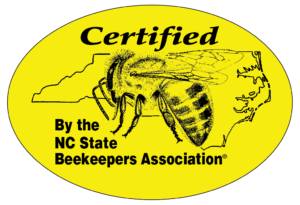Homegrown Honey? Maybe, Maybe Not
go.ncsu.edu/readext?730333
en Español / em Português
El inglés es el idioma de control de esta página. En la medida en que haya algún conflicto entre la traducción al inglés y la traducción, el inglés prevalece.
Al hacer clic en el enlace de traducción se activa un servicio de traducción gratuito para convertir la página al español. Al igual que con cualquier traducción por Internet, la conversión no es sensible al contexto y puede que no traduzca el texto en su significado original. NC State Extension no garantiza la exactitud del texto traducido. Por favor, tenga en cuenta que algunas aplicaciones y/o servicios pueden no funcionar como se espera cuando se traducen.
Português
Inglês é o idioma de controle desta página. Na medida que haja algum conflito entre o texto original em Inglês e a tradução, o Inglês prevalece.
Ao clicar no link de tradução, um serviço gratuito de tradução será ativado para converter a página para o Português. Como em qualquer tradução pela internet, a conversão não é sensivel ao contexto e pode não ocorrer a tradução para o significado orginal. O serviço de Extensão da Carolina do Norte (NC State Extension) não garante a exatidão do texto traduzido. Por favor, observe que algumas funções ou serviços podem não funcionar como esperado após a tradução.
English
English is the controlling language of this page. To the extent there is any conflict between the English text and the translation, English controls.
Clicking on the translation link activates a free translation service to convert the page to Spanish. As with any Internet translation, the conversion is not context-sensitive and may not translate the text to its original meaning. NC State Extension does not guarantee the accuracy of the translated text. Please note that some applications and/or services may not function as expected when translated.
Collapse ▲Honey is truly one of nature’s bounties. It’s considered to be an almost perfect food. It can last forever and is used for more than just eating. It requires little attention after it comes out of the hive. It has no additives, can be found almost anywhere and each jar has its own unique taste of the region in which it is made.
Local honey is what most people are looking for and in most cases it is readily available at local farmer’s markets and roadside stands. Many folks have a relationship with a local beekeeper and maintain a supply straight from the hive.
But how do you know it is local honey? If you know a beekeeper and can observe his hives it is a pretty safe bet that your honey came from someone’s backyard down the road. The Burke County Beekeeper’s Association is also a good resource for local honey and a phone call to your local Extension Office (828-764-9480) can get you some reliable contacts.
But if you don’t have those resources, how can you tell if your honey is local or even 100% pure honey? Much of the commercially sold honey comes from other countries and those sources sometimes use additives such as high fructose corn syrup in their honey. Some of this honey is processed to remove pollen (which is beneficial) and to prevent the honey from crystallizing which is a natural occurrence in honey and not harmful to the honey. As of 2016, only 29% of the honey sold in the US was domestically produced. But in NC there are labeling laws and some websites that you can check out to see if your honey is indeed, being produced in NC. Go to the North Carolina State Beekeepers Association website for a listing of local honey producers. Also, check the label for a certified NC honey label.

When buying from a retail outlet the label can provide valuable information about your honey and it’s origin. The label might have an NC honey producer’s name on it but look to see if it says “packaged in NC”. If this is the case, the honey could have come from an outside source but re-packaged once it gets to a commercial honey seller. Graded honey which is mostly what is found in grocery stores is almost always foreign honey. It will have the country of origin on the label but that isn’t always accurate. Honey that has been highly filtered has no pollen left in it so that it’s country of origin is untraceable. Some countries have traces of antibiotics in their honey. Another clue is the price. If the price is considerably lower than most other honey, it is probably not pure and is probably from a foreign source. Federal law states that honey is only required to have the weight in ounces and grams listed and the name and address of the producer.
North Carolina guidelines require the name “Honey” on the label and the pollen source may be listed if a significant amount of a specific pollen is present such as sourwood honey. The name, address and zip code of the producer or the website is required and the weight in pounds, ounces or grams must be displayed on the lower 30% of the label. It is interesting to note that most honey is being sold by the pound nowadays. Another tidbit is that 16 ounces or 1 pound of honey is different from 16 fl. ounces. A pound of honey is not quite a pint.
But, the bees have been generous this year and there’s plenty of good, local, pure honey in Burke County for anyone who wants it. Find a local beekeeper and try some out this year.




